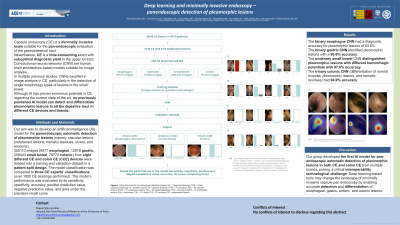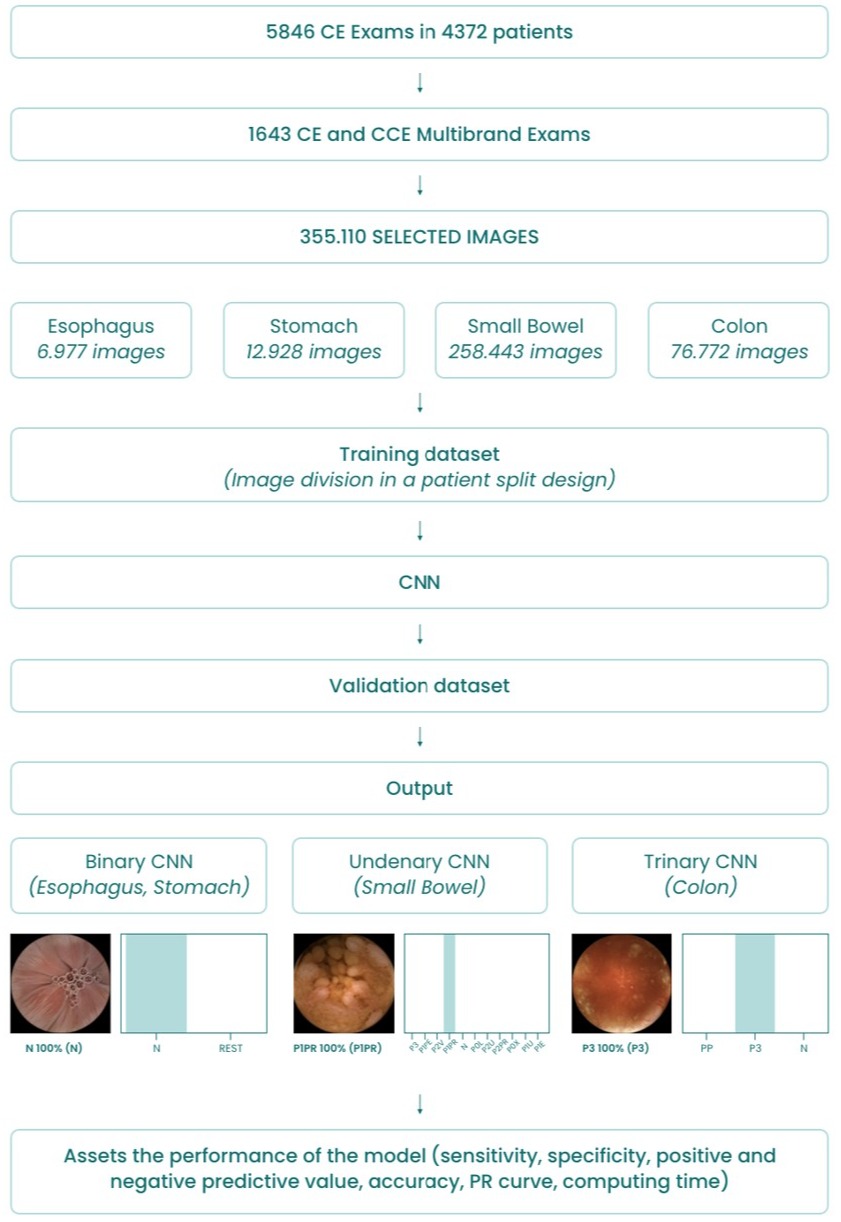Sunday Poster Session
Category: General Endoscopy
P0547 - Deep Learning and Minimally Invasive Endoscopy – Panendoscopic Detection of Pleomorphic Lesions
Sunday, October 22, 2023
3:30 PM - 7:00 PM PT
Location: Exhibit Hall

Has Audio

Miguel Mascarenhas, MD
Centro Hospitalar São João
Porto, Porto, Portugal
Presenting Author(s)
Miguel Mascarenhas, MD1, João PL. Afonso, MD2, Tiago Ribeiro, MD1, Pedro Cardoso, MD1, Francisco Mendes, MD1, Miguel Martins, MD1, Ana Andrade, MD1, Hélder Cardoso, MD2, João Ferreira, PhD3, Guilherme Macedo, MD, PhD2
1Centro Hospitalar São João, Porto, Porto, Portugal; 2Centro Hospitalar de São João, Porto, Porto, Portugal; 3University of Porto-FEUP, Porto, Porto, Portugal
Introduction: Capsule endoscopy (CE) is a minimally invasive exam suitable for the pan-endoscopic evaluation of the gastrointestinal tract. Nevertheless, CE is a time-consuming exam with suboptimal diagnostic yield in the upper GI tract. Convolutional neural networks (CNN) are human brain architecture-based models suitable for image analysis. In multiple previous studies, CNNs excelled in image analysis in CE, particularly in the detection of single morphology types of lesions in the small bowel. Although AI has proven enormous potential in CE, regarding the current state of the art, no AI model can detect and differentiate pleomorphic lesions in all the digestive tract in different CE devices and brands.
Methods: Our aim was to develop an artificial intelligence (AI) model for the panendoscopic automatic detection of pleomorphic lesions (namely vascular lesions, protuberant lesions, hematic residues, ulcers, and erosions). 355110 images (6977 esophageal, 12918 gastric, 258443 small bowel, 76772 colonic) from eight different CE and colon CE (CCE) devices were divided into a training and validation dataset in a patient split design. The model classification was compared to three CE experts’ classifications (over 1000 CE readings performed). The model’s performance was evaluated by its sensitivity, specificity, accuracy, positive predictive value, negative predictive value, and area under the precision-recall curve.
Results: The binary esophagus CNN had a diagnostic accuracy for pleomorphic lesions of 83.6%. The binary gastric CNN identified pleomorphic lesions with a 96.6% accuracy. The undenary small bowel CNN distinguished pleomorphic lesions with different hemorrhagic potentials with 97.6% accuracy. The trinary colonic CNN (detection and differentiation of normal mucosa, pleomorphic lesions, and hematic residues) had 94.9% global accuracy.
Discussion: Our group developed the first AI model for pan-endoscopic automatic detection of pleomorphic lesions in both CE and colon CE from multiple brands, solving a critical interoperability technological challenge. Deep learning-based tools may change the landscape of minimally invasive capsule pan endoscopy by enabling accurate detection and differentiation of esophageal, gastric, enteric, and colonic lesions.

Disclosures:
Miguel Mascarenhas, MD1, João PL. Afonso, MD2, Tiago Ribeiro, MD1, Pedro Cardoso, MD1, Francisco Mendes, MD1, Miguel Martins, MD1, Ana Andrade, MD1, Hélder Cardoso, MD2, João Ferreira, PhD3, Guilherme Macedo, MD, PhD2. P0547 - Deep Learning and Minimally Invasive Endoscopy – Panendoscopic Detection of Pleomorphic Lesions, ACG 2023 Annual Scientific Meeting Abstracts. Vancouver, BC, Canada: American College of Gastroenterology.
1Centro Hospitalar São João, Porto, Porto, Portugal; 2Centro Hospitalar de São João, Porto, Porto, Portugal; 3University of Porto-FEUP, Porto, Porto, Portugal
Introduction: Capsule endoscopy (CE) is a minimally invasive exam suitable for the pan-endoscopic evaluation of the gastrointestinal tract. Nevertheless, CE is a time-consuming exam with suboptimal diagnostic yield in the upper GI tract. Convolutional neural networks (CNN) are human brain architecture-based models suitable for image analysis. In multiple previous studies, CNNs excelled in image analysis in CE, particularly in the detection of single morphology types of lesions in the small bowel. Although AI has proven enormous potential in CE, regarding the current state of the art, no AI model can detect and differentiate pleomorphic lesions in all the digestive tract in different CE devices and brands.
Methods: Our aim was to develop an artificial intelligence (AI) model for the panendoscopic automatic detection of pleomorphic lesions (namely vascular lesions, protuberant lesions, hematic residues, ulcers, and erosions). 355110 images (6977 esophageal, 12918 gastric, 258443 small bowel, 76772 colonic) from eight different CE and colon CE (CCE) devices were divided into a training and validation dataset in a patient split design. The model classification was compared to three CE experts’ classifications (over 1000 CE readings performed). The model’s performance was evaluated by its sensitivity, specificity, accuracy, positive predictive value, negative predictive value, and area under the precision-recall curve.
Results: The binary esophagus CNN had a diagnostic accuracy for pleomorphic lesions of 83.6%. The binary gastric CNN identified pleomorphic lesions with a 96.6% accuracy. The undenary small bowel CNN distinguished pleomorphic lesions with different hemorrhagic potentials with 97.6% accuracy. The trinary colonic CNN (detection and differentiation of normal mucosa, pleomorphic lesions, and hematic residues) had 94.9% global accuracy.
Discussion: Our group developed the first AI model for pan-endoscopic automatic detection of pleomorphic lesions in both CE and colon CE from multiple brands, solving a critical interoperability technological challenge. Deep learning-based tools may change the landscape of minimally invasive capsule pan endoscopy by enabling accurate detection and differentiation of esophageal, gastric, enteric, and colonic lesions.

Figure: Fig. 1 – Study flow chart for the training and validation phases. CE – Capsule Endoscopy; CCE – Colon Capsule Endoscopy; N – normal mucosa; P3 – hematic residues; P1PE – P1 red spots; P2V – P2 vascular lesions; P1PR – P1 protuberant lesions; P0L – P0 lymphangiectasia; P2U – P2 ulcers; P2PR – P2 protuberant lesions; P0X - xanthomas; P1U – P1 ulcers; P1E – P1 erosions; PP – pleomorphic lesions
Disclosures:
Miguel Mascarenhas indicated no relevant financial relationships.
João Afonso indicated no relevant financial relationships.
Tiago Ribeiro indicated no relevant financial relationships.
Pedro Cardoso indicated no relevant financial relationships.
Francisco Mendes indicated no relevant financial relationships.
Miguel Martins indicated no relevant financial relationships.
Ana Andrade indicated no relevant financial relationships.
Hélder Cardoso indicated no relevant financial relationships.
João Ferreira indicated no relevant financial relationships.
Guilherme Macedo indicated no relevant financial relationships.
Miguel Mascarenhas, MD1, João PL. Afonso, MD2, Tiago Ribeiro, MD1, Pedro Cardoso, MD1, Francisco Mendes, MD1, Miguel Martins, MD1, Ana Andrade, MD1, Hélder Cardoso, MD2, João Ferreira, PhD3, Guilherme Macedo, MD, PhD2. P0547 - Deep Learning and Minimally Invasive Endoscopy – Panendoscopic Detection of Pleomorphic Lesions, ACG 2023 Annual Scientific Meeting Abstracts. Vancouver, BC, Canada: American College of Gastroenterology.
